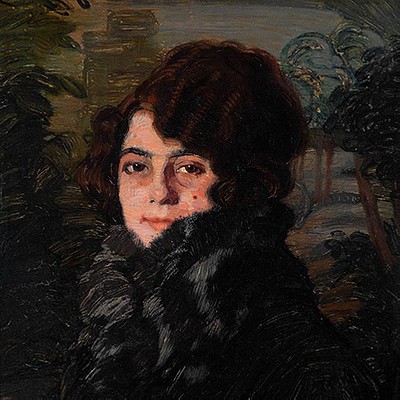CECILIO PLÁ GALLARDO (Valencia, 1860 - Madrid, 1934). "Female portrait. Oil on canvas.
Lot 27
About Seller
Setdart Auction House
Carrer Aragó 346
Barcelona
Spain
Setdart Subastas was born in 2004 and is currently the first online art auction in Spain with solidity, prestige and reliability guaranteed by our more than 60,000 users. Setdart has a young, dynamic and enterprising team ready to successfully manage the purchase and sale of art works through custom...Read more
Estimate:
EUR€15,000 - EUR€18,000
$16,304.35 - $19,565.22
Absentee vs Live bid
Two ways to bid:
- Leave a max absentee bid and the platform will bid on your behalf up to your maximum bid during the live auction.
- Bid live during the auction and your bids will be submitted real-time to the auctioneer.
Bid Increments
| Price | Bid Increment |
|---|---|
| EUR€0 | EUR€10 |
| EUR€200 | EUR€25 |
| EUR€500 | EUR€50 |
| EUR€1,000 | EUR€100 |
| EUR€3,000 | EUR€200 |
| EUR€5,000 | EUR€500 |
| EUR€10,000 | EUR€1,000 |
| EUR€20,000 | EUR€2,000 |
| EUR€50,000 | EUR€5,000 |
About Auction
By Setdart Auction House
Jul 15, 2021
Set Reminder
2021-07-15 08:00:00
2021-07-15 08:00:00
America/New_York
Bidsquare
Bidsquare : 19th & 20th CENTURY PAINTINGS & ORIENTALISM
https://www.bidsquare.com/auctions/setdart-auction-house/19th-20th-century-paintings-orientalism-7212
Setdart Auction House sofia@setdart.com
Setdart Auction House sofia@setdart.com
- Lot Description
CECILIO PLÁ GALLARDO (Valencia, 1860 - Madrid, 1934). "Female portrait. Oil on canvas. Signed in the lower right corner. With label of the Sala Parés on the back. Size: 76 x 63 cm; 98 x 83 cm (frame). Cecilio Pla initiates his formation in the Academy of Fine Arts of San Carlos of Valencia, to continue later in that of San Fernando of Madrid, where he had Emilio Sala as teacher. In 1880 he made a study trip to Rome, visiting Italy, France and Portugal. From there he began to send works to the National Exhibitions of Fine Arts, being awarded a third medal in 1884 for the work of Italian theme "The Dante: circle of the greedy", and second medal in 1887 for the religious canvas entitled "Burial of Santa Leocadia". In 1892 he obtained again a second medal for the realistic painting of social intention "Las doce (el almuerzo)", and the same award in 1895 for a scene of conjugal disagreement in a bourgeois interior, "Lazo de unión". Pla continued to participate in the National Exhibitions throughout his life, obtaining in 1910 consideration of first medal for the painting "Two Generations", characterized by the different effects of natural light that were the true specialty of this artist. That same year of 1910 he replaced his former teacher Emilio Sala in the class of color aesthetics and pictorial procedures at the San Fernando Academy, where he taught Juan Gris, Francisco Bores, Pancho Cossío and José María López Mezquita, among others. It was then that he published his "Cartilla de arte pictórico". Pla also participated in international competitions, being awarded a medal of honor at the Universal Exposition of Paris in 1900. In 1924 he was named academician of San Fernando. He alternated his teaching activity with painting, as well as collaborating as an illustrator with publications such as "La Ilustración Española y Americana", "Blanco y Negro" and "La Esfera". He also made posters, such as the one for the Carnival of the Círculo de Bellas Artes in 1892, and participated in mural decorations, including the ceiling of the hotel of the Infanta Isabel de Borbón, the Casino of Madrid, the Círculo de Bellas Artes or the palace of the Dukes of Denia. Considered the greatest exponent of Valencian modernist painting, he nevertheless embraced different tendencies, from the academicism and costumbrismo of his beginnings to the Wagnerianism and luminism of his coastal views painted in Valencia. Currently, Cecilio Pla is represented in the Prado Museum, the Thyssen-Bornemisza Museum, the Fine Arts Museums of Valencia, Zaragoza, Santander and Bilbao, the Círculo de Bellas Artes of Madrid, the City Hall of Valencia and the Royal Academy of Fine Arts of San Carlos, among other public and private collections, such as the UEE Collection. In 1999, the Mapfre Foundation dedicated an extensive retrospective to him.
- Shipping Info
-
In-house shipping available. Please inquire at admin@setdart.com.
-
- Buyer's Premium



 EUR
EUR CAD
CAD AUD
AUD GBP
GBP MXN
MXN HKD
HKD CNY
CNY MYR
MYR SEK
SEK SGD
SGD CHF
CHF THB
THB
















